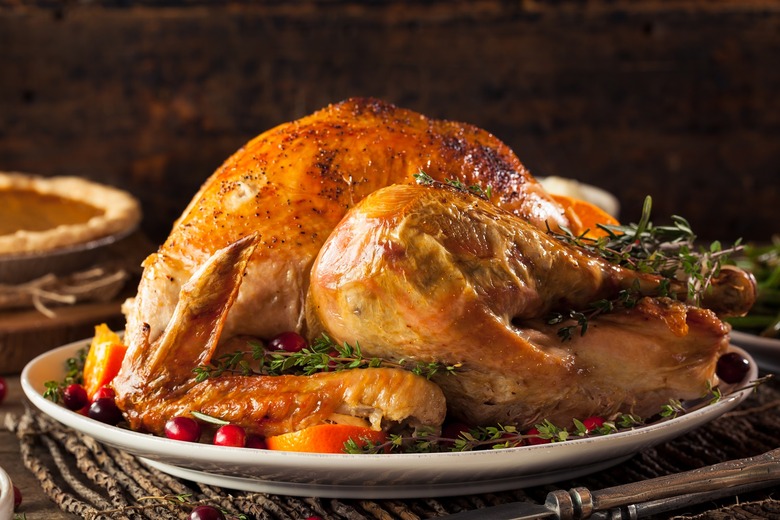9 Secrets For A Perfect Thanksgiving Turkey
If you're not used to it, cooking for Thanksgiving can be straight-up terrifying. And one of the most common holiday questions is: How do you even cook a turkey? Even if you follow the best recipes for roasting, frying and everything in between, some crucial steps and techniques for delivering a great turkey are left out. These are the kinds of things that can make or break your meal but are often only learned from experience.
We are going to save you the pain of learning the hard way.
Make sure the turkey is thoroughly thawed
The first step to making sure you have a great holiday turkey actually starts several days before Thanksgiving itself. You need to properly and thoroughly thaw your turkey. This is especially important if you're deep-frying your turkey (ice crystals plus hot oil equals bad news).
It's recommended that you put your turkey in the fridge one day for every 4 pounds (not counting Thanksgiving Day or the day before if you're brining your turkey). So put an 18-pound bird in your fridge on the Saturday before Thanksgiving at the latest.
To check that your turkey is fully thawed, remove the giblets and neck from the inside of your turkey and have a feel around the cavity. Any ice crystals? If no, you're in luck. If yes, do a cold water thaw for 30 minutes at a time until the ice is gone and an instant-probe thermometer inserted into the breast of the turkey reads between 32 and 40 degrees. Make sure the turkey does not get above 40 degrees, lest you risk food poisoning. That means you shouldn't let your turkey defrost on the counter or in a warm water bath.
Pat the skin dry
The secret to crispy turkey skin? It's not basting your turkey — it's making sure the bird's skin is extra dry before cooking. Pat the outside (and inside) of your turkey with paper towels before cooking to dry it out.
Season outside AND inside, generously
Proper seasoning is the key to making any protein delicious, even if you're just using simple salt and pepper. Season the outside of your turkey, but do so under the skin to make sure the seasoning really reaches all the meat. And don't neglect seasoning the cavity of your turkey too. This also helps to maximize the flavor of your bird.
Embrace aromatics
While you can cook stuffing inside of your turkey, it's not the safest way to make this holiday side. Prepare your stuffing in a separate casserole dish instead, but don't leave that cavity empty. Loosely stuff the inside of your turkey with aromatics, like garlic cloves, cut-up citrus, onions and herbs. These add holiday flavor to your bird and its drippings, leading to excellent gravy.
Take the temperature correctly
Don't just rely on a turkey pop-up timer to make sure your bird is done — check the internal temperature of the bird. According to the United States Department of Agriculture, a turkey is safely cooked when its internal temperature reaches 165 degrees F. Use an instant probe thermometer and take the temperature in the innermost part of the thigh and wing as well as the thickest part of the breast. Just be sure you don't go so deep as to hit bone.
Let the turkey rest
If turkey has a reputation for being dry, it's usually because many home cooks miss a crucial step: Letting the turkey rest. No need to tent it with foil or a towel — that can make the skin soggy. Just let it sit for between 45 and 90 minutes before carving. This allows the juices to redistribute, leading to moist meat.
Strain the gravy
Nobody wants a random sprig of thyme or a tiny chunk of skin in their turkey gravy. After using the pan drippings to make a savory, scrumptious gravy, don't skip the crucial step of pouring the gravy through a fine mesh strainer. This will help to catch rogue bits of meat, skin, roux and herbs.
Carve in the kitchen
Carving the turkey is not a pretty process. It starts with popping the legs out of the joints and only gets messier from there. You need your space, so give yourself some. Set up a full carving station in your kitchen with a large cutting board, plenty of paper towels, a sharp chef's knife and a serving platter.
Relax
Even the best turkey recipes always omit one key element: calm. Whether you're preparing a modern Thanksgiving menu or keeping it to a traditional Thanksgiving with all the trimmings, there's no need to stress out about the turkey. The fact is, most folks don't prep this big bird often — and turkey is BIG — so it can feel like a daunting task. But the base of any recipe is to have a defrosted turkey, season the bird, put it in a roasting pan and then let the oven do the work. As long as the turkey reaches a food-safe temperature of 165 degrees, it'll be edible.
Remember, if the turkey is dry, bland or shredded to bits during carving, most mistakes can be covered up with some good ol' fashioned gravy.
